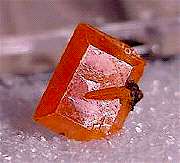Wulfenite
by
Dave Babulski, Ed.D.
("Tips and Trips", Vol. XXXIII/8, August 2004, page 10.)

This month's installment of the Micromount Corner will address the "Wonderful World of Wulfenite". Named after the Austrian mineralogist, Franz Xavier von Wulfen (1728 – 1805), wulfenite is one of the most sought after micromount specimens. Officially classed as a lead molybdate, although other elements can sometimes substitute for lead, providing a range of mineral compositions. Like the mineral calcite, wulfenite crystallizes in a number of habits and appears in a wide range of colors from white to black and a whole range from yellow to red. There is even a green Wulfenite. This mineral occurs in the oxidized portion of zinc-lead deposits and as such is often associated with other colorful secondary lead zinc minerals. Fortunately for the micro-mounter, some of the crystal habits of wulfenite only occur as micro-crystals. The Fourth Edition of Dana's Handbook of Mineralogy has some very nice drawings of the more common wulfenite crystal habits.
The most common crystal habits are:
- Thick and thin tabular plates with beveled edges,
- Prismatic crystals with pyramidal terminations,
- Bi-pyramidal pseudooctahedral crystals. These are usually very small and are exceedingly rare,
- Thin tabular plates with the corners clipped forming an octahedral outline, and
- Blocky octahedral looking crystals.

Copyright © Georgia Mineral Society, Inc.
